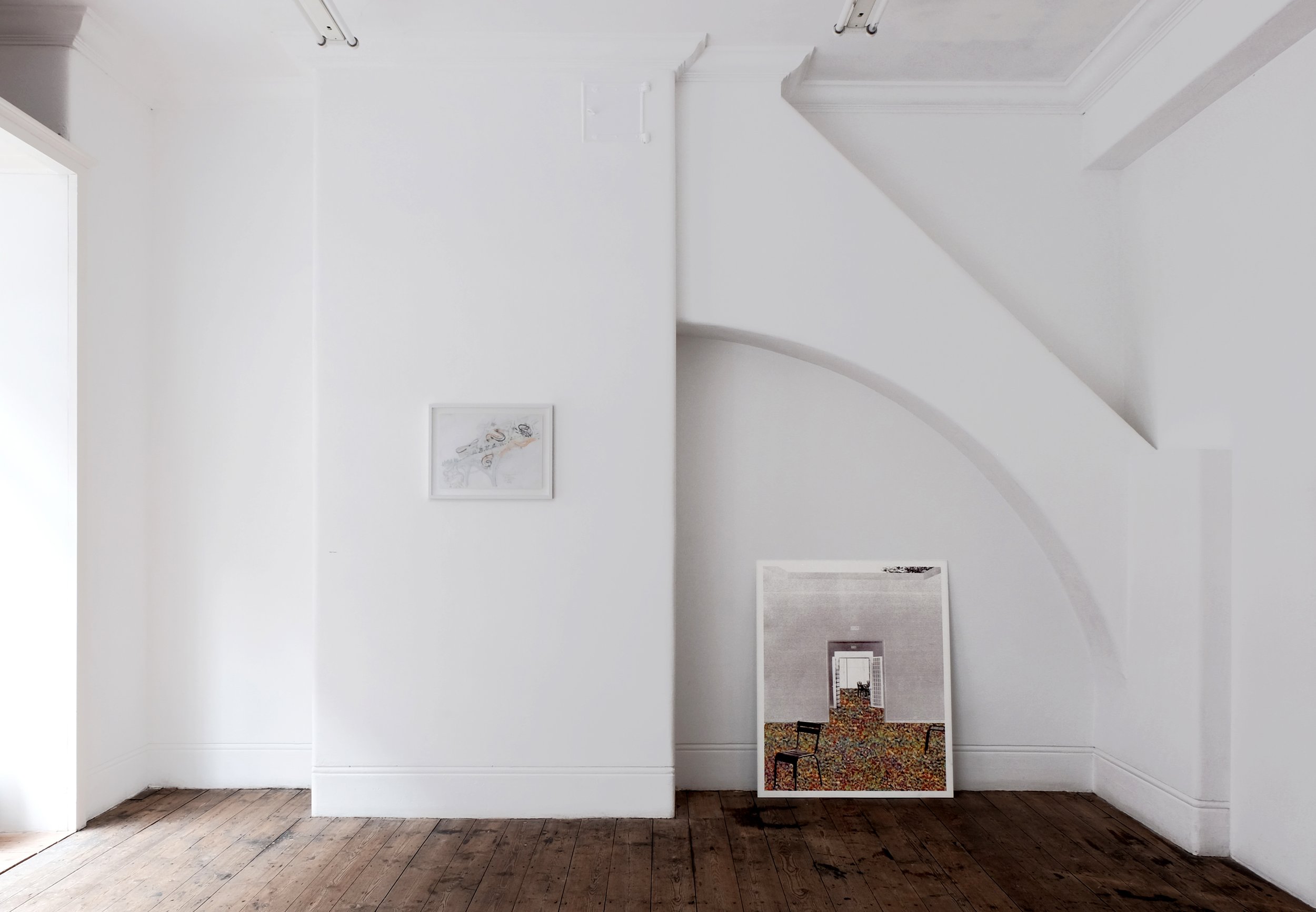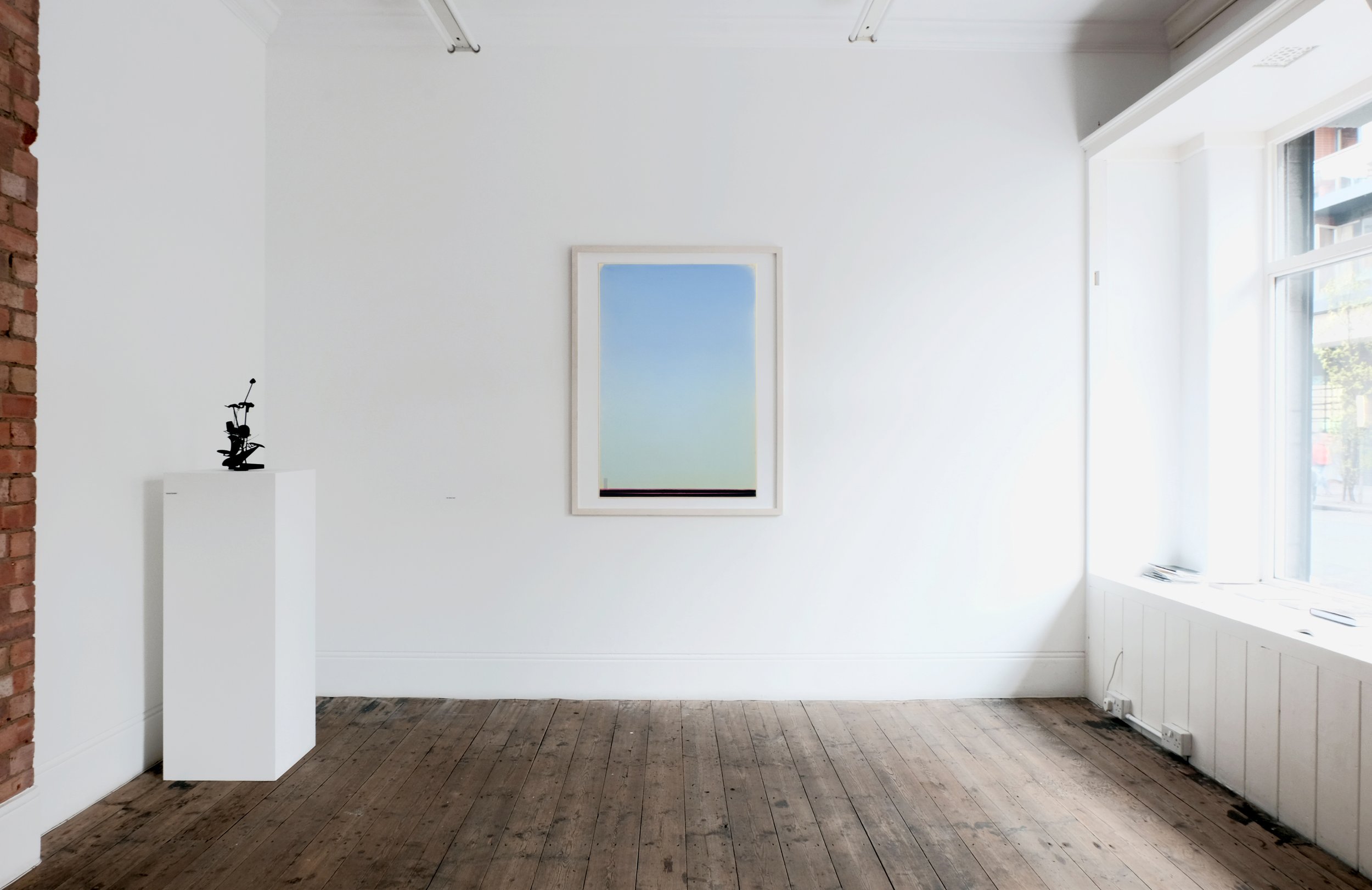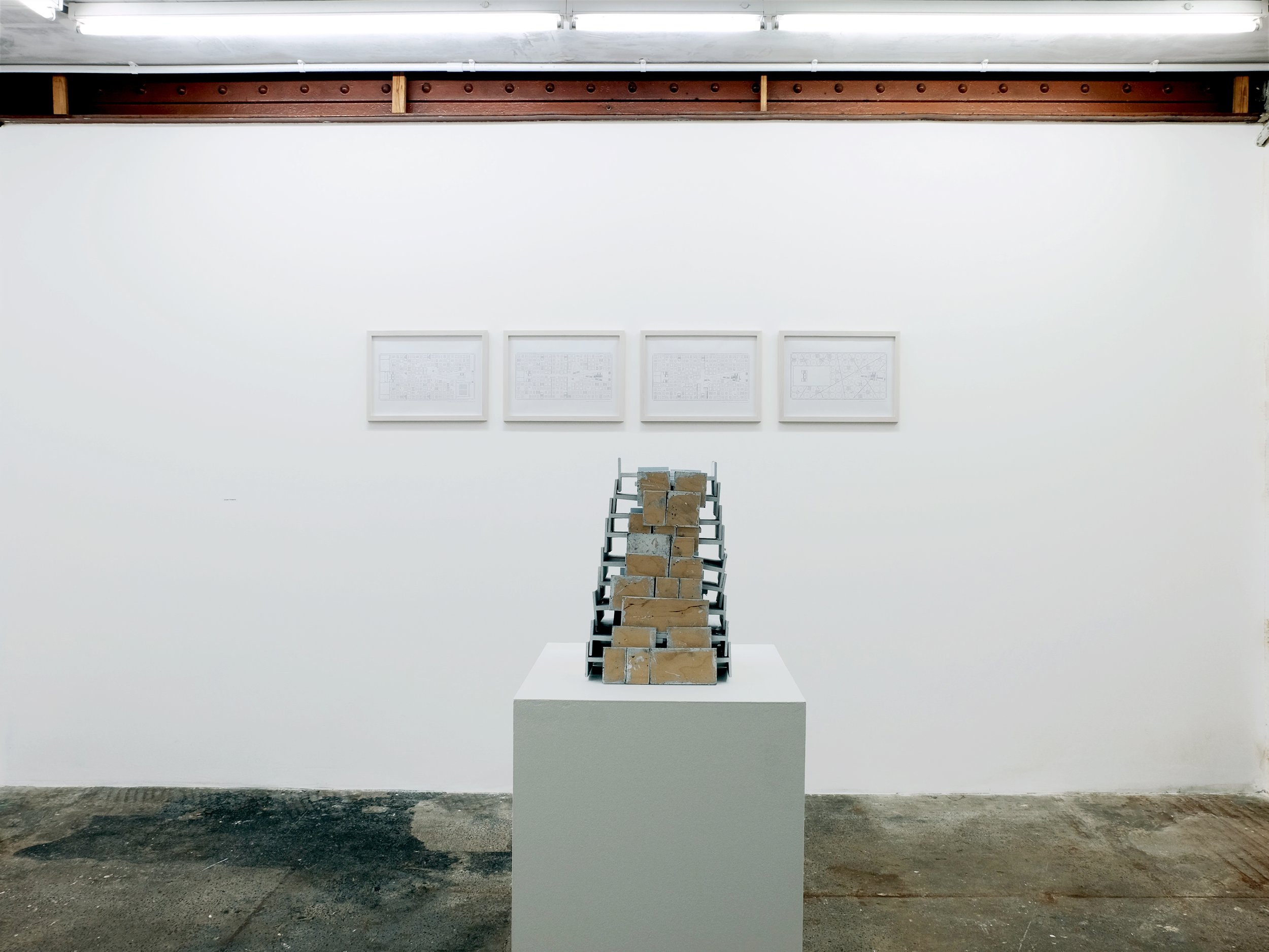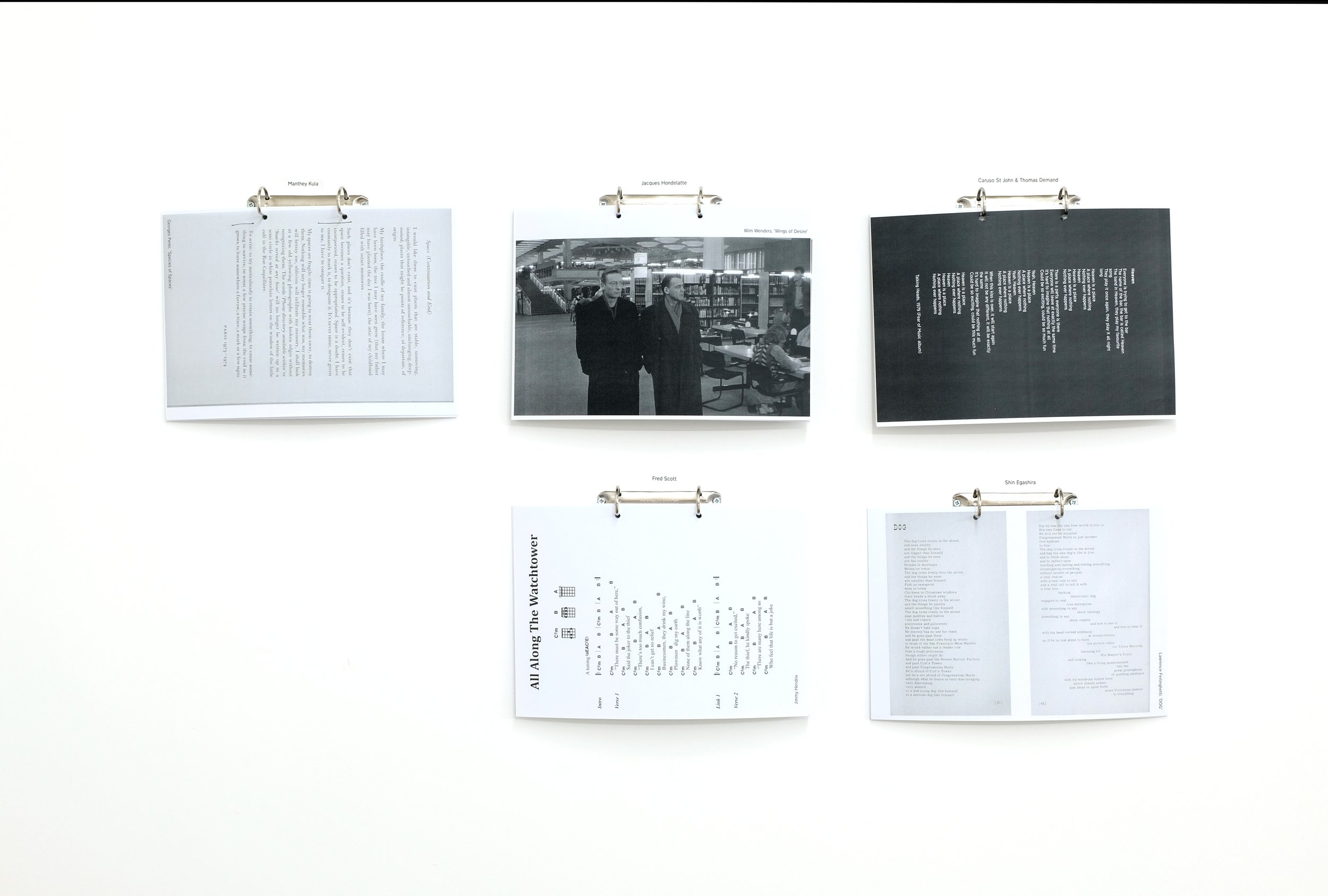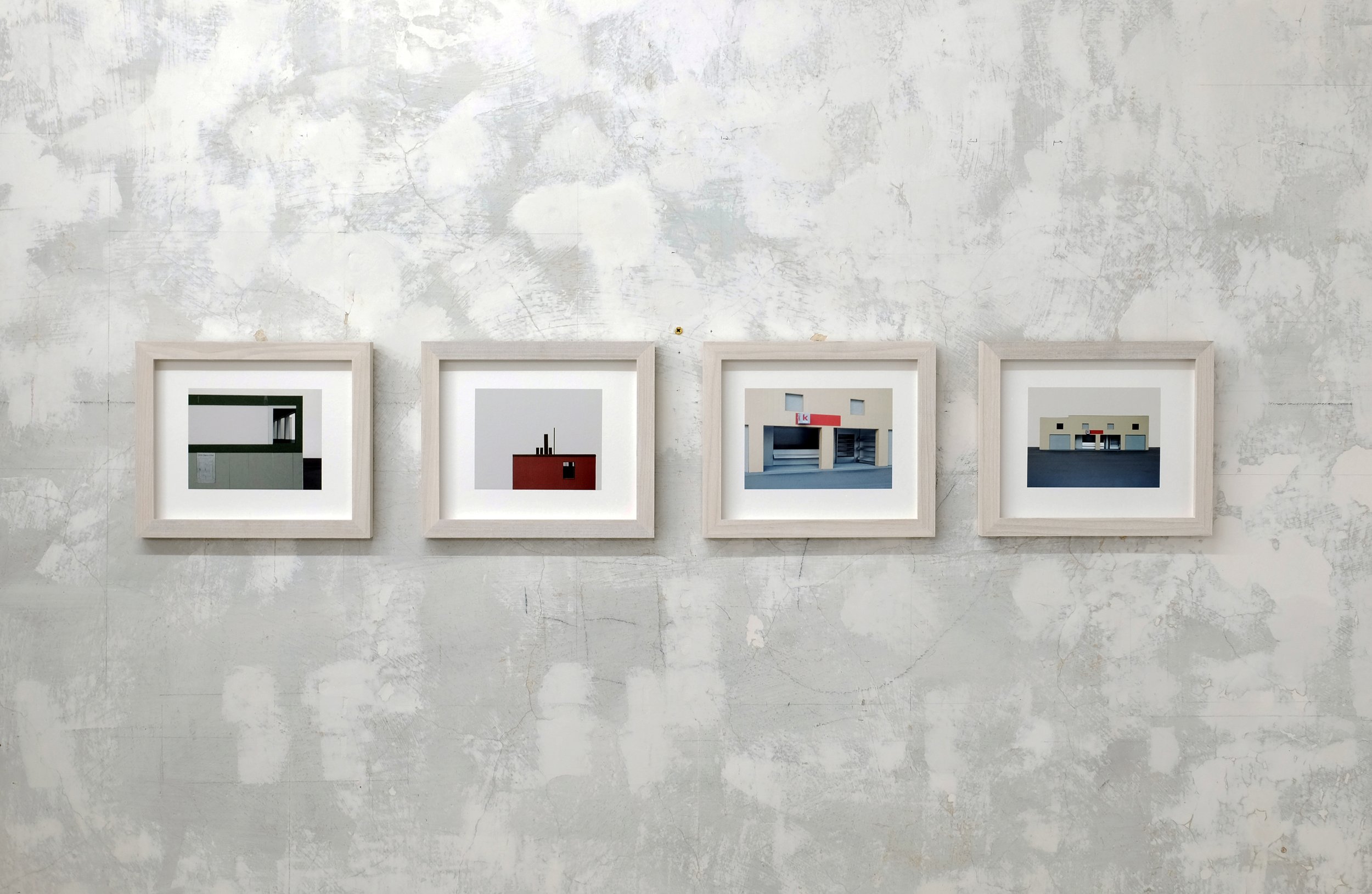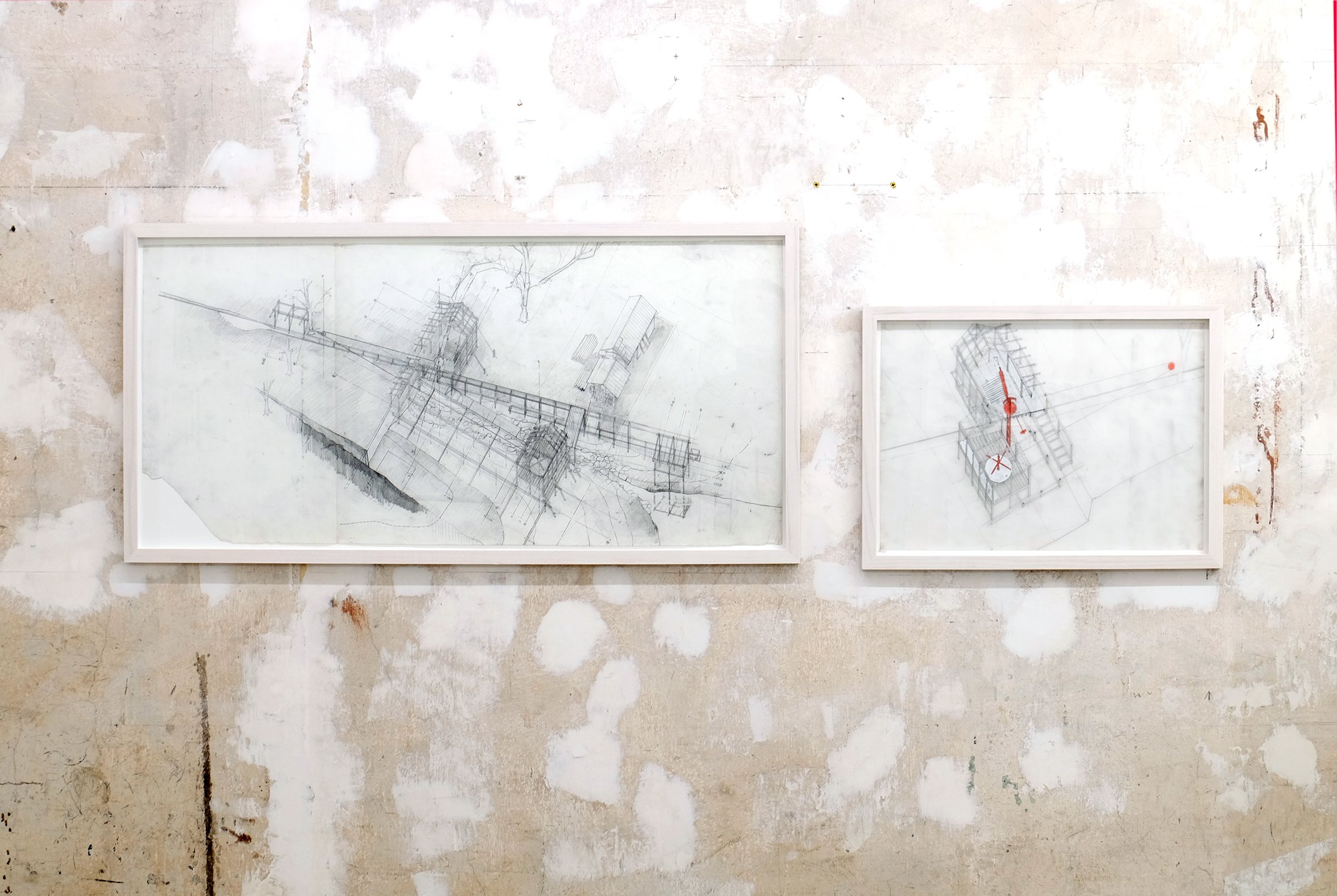Namely, words | Part 2
Pier Vittorio Aureli
Caruso St John with Thomas Demand
Nigel Coates
Shin Egashira
Richard Goodwin
Jacques Hondelatte
Manthey Kula
Office Kersten Geers David Van Severen
Fred Scott
‘Namely, words: part 2’, is the second installment of the exhibition at Betts Project; the first part opened in May 2021 after the easings of various lockdowns. The group show brings together and celebrates the work of architects and artists who have exhibited at the gallery since it opened in March 2013.
Namely, words’ is dedicated to the common and at times intricate ground between architecture and writing. Questioning the notion of drawing and building as being the primary medium of the architect, this exhibition turns to literature for alternative reflections towards architecture and to enrich the way we think and talk about architectural practice.
Writing and making often utilise a shared conceptual vocabulary — structure, narrative, texture, style — and have each played key roles in the cultural experience of modernity. Through a series of 18 paired dialogues of drawing and text, ‘Namely, words’ seeks to explore writing’s capacity to engage with the lived experience of place and reveal the dialogue between architecture and writing as complex and inseparable social practices.
For this exhibition, Betts Project invited architects to present either a new or existing drawn or sculpted work and to accompany it with a piece of writing they admire. The exhibition reads in the same way as an annotated book; the literary choices act as postscripts to the works in the exhibition, becoming a way of re-reading the works, while assigning new definitions through the use of text.
In the exhibition, multiple copies of the texts are hung on the wall for visitors to tear off and take home. An exhibition catalogue also containing part 1 of the series will follow.
Part 1 of ‘Namely, words’ included: Alexander Brodsky, Philip Christou, Tony Fretton, Günter Günschel, Sam Jacob, Peter Märkli, Studio Mumbai/Bijoy Jain, Denise Scott Brown, Inge Vinck, Jan de Vylder, Peter Wilson and Zoe Zenghelis
Works on view
Nigel Coates
Triangolone Frienze, 2018
Pencil and pen, tracing paper, paper
42 x 29 cm
Unique
Mina Loy, Aphorisms on Futurism. Text selected by Nigel Coates
NIGEL COATES
Triangolone Frienze
2018
The text I've chosen is by Mina Loy, a feminist and ardent Futurist who, around 1914, was living in Florence. She had a brief affair with Martinetti and with the political editor of Lacerba magazine, Giovanni Papini. She showed her paintings in the First Free Exhibition of International Futurism in the Galleria Sprovieri near the duomo in the city, and together, they would socialise with other artists and writers at the famous Giubbe Rosse in Piazza Repubblica.
The drawing explores an alternative approach to the area north of the centre and site for the new Foster-designed high speed rail station in a vast underground bunker under the existing railway lines. The railways have a natural symbiosis with Futurist ideas, an overlap made all the more relevant by a one of the most overt Futurist structures, the Centrale Termica, still standing by the railway near to the existing Santa Maria Novella terminus.
The drawing represents a series of organic connections and dynamic eddies that build on the inherent movement suggested by the railway. My proposal includes four enclaves that sit comfortably within the existing urban fabric, yet distinguish themselves with programmes of each that infiltrate their neighbours.
The first of these (top left) is a contemporary factory based on digital production and is adjacent to an industrial archive for the city; secondly (centre top) a community workshop that incorporates its own marketplace; and thirdly (top right) a new piazza that hosts startups and a packed calendar of festive events. The railway lines are crossed by underpasses and Hadid-style zigzag bridge accessing the high speed platforms. To the south a new arts centre (literally) revolves around a particularly dynamic piece of industrial heritage - the turntable for railway locomotives and carriages. Exhibitions do not simply generate new displays, but entire configurations of the museum environment made possible by special configurations of dedicated rolling stock.
The overlap with Loy's Aphorisms is more cultural than literal. In the hands of others often glorifying war and a relentless drive to industrialise, the Futurist project has a more subtle and humanist thread in her words. She advocates freedom and optimisation rather than any kind of triumphalism. Her feminist politics and the way she handles misogynistic dismissal ring true today. Her concern for expressing ideas as an artist rather than an architect chime for me as inspiration for architecture and the city.
Office Kersten Geers David Van Severen
After the party, Venice, 2008
105 x 85 cm
Digital Print on White Lakered Aluminum, printed in 2013
Edition of 3
Don Delillo, The Names (published by Alfred A. Knopf, 1982). Text selected by Office Kersten Geers David Van Severen
OFFICE KERSTEN GEERS DAVID VAN SEVEREN
After The Party
Giardini, Venice, Italy
2007 – 2008
In the Belgian pavilion for the 2008 Venice Biennial the existing pavilion is enclosed by a seven-metre high wall, and thus separated from the predominant context of the architecture biennial. The floor of both the existing pavilion and the new ‘garden’ is covered with a layer of confetti. Chairs are spread here and there around the new pavilion. The existing awning under the skylights of the pavilion was removed so that sunlight streams directly in. Visitors walk through between the two layers of the outer wall and enter the original pavilion through a side entrance, disorienting them before their experience of a new aggregate of spaces. In the new walled garden of the pavilion one can sit in the sun or under the shade of trees. The new Belgian pavilion frames and displays the original pavilion, a piece of architecture that has been constantly adapted and transformed over the years.
Belgian Pavilion for the Venice Bienneal of Architecture 2008. Invited competition among 13 young Belgian practices, 1st prize. Photos by Bas Princen.
Richard Goodwin
Stealth Anticlimax, 2010
Bronze
50 x 40 x 37.5 cm
VITO ACCONCI
COMING OUT (NOTES ON PUBLIC ART) NOVEMBER 1987
Two models for public art: the curb and the spaceship.
The curb, or the lamppost, or the fire hydrant, goes almost unnoticed; it’s as if it’s always been there. This kind of public art blends in with its surroundings, and can criticize from within. The spaceship lands in an alien place; it revels in its look as if it came out of nowhere, it makes no attempt at camouflage to fit its surroundings. This kind of public art can criticize from the outside, like a future-studies scenario. (The contemporary version of the spaceship is the park, which is set up as an oasis inside the city, separate from the city. The park substitutes greenery from a past time for the spaceship’s white of the future.)
Being there: thinking from the inside out
Being in the world means being encased in the world. Our habit of thinking is: in order to analyze the world you have to step outside the world, jump out of the world. This habit of thinking, and of talking, allows the construction of a self to exist (you “go out of your self”, you “take your self out of it”). The implication is that, as long as you’re inside the world, you’re too close to the world to think about it; you can’t experience and analyze at the same time. But, no matter how far you go, mentally, out of the world, you’re still physically inside it. Taking yourself out of the world, mentally, means only a retreat from material conditions, on the one hand, and from people, on the other. The implication is that you can think only when you’re alone, only when you withdraw into a meditation chamber. One function of public art is to re-imbed a person inside material conditions and within the company of other people; one function of public art is to learn, and teach, a simultaneity of experience and analysis; one function of public art is to undo the construction of a self.
Vito Acconci, Coming Out. Selected by Richard Goodwin
Pier Vittorio Aureli
Untitled, Piccolomini, 2017
Pastel on paper
110 x 75 cm
Robert Lax, Forms. Selected by Pier Vittorio Aureli
PIER VITTORIO AURELI
Untitled, Piccolomini Series
2017
The drawing plays with the most fundamental datum of the landscape genre, which is the horizon line. In painting, the horizon line is the axis through which, in the last six centuries, every Western depiction of space has been constructed. The horizon line is the most artificial and arbitrary datum though which we produce representations of space, and yet it has become one of the most potent means of naturalizing our perception of space. All the conflicts, cracks, and contradictions that have produced the land as we see it are subsumed and equalized by the establishment of the horizon line.
For centuries the horizon remained hidden behind elaborate compositions. It was only in17th century Dutch and Flemish landscape painting that the horizon line was made visible as the most explicit feature of the painting itself. In the paintings of Jan Porcellis, Jacob van Ruisdael and Pieter Snayers, the horizon becomes so overwhelming that it completely subsumes the vanishing point and any compositional feature that is not just the axis of the horizon.
Manthey Kula
Cake from Munch, 2018
Plywood, magnetic paint, paint
H33 x 23 x 23 cm
Georges Perec, Species of Spaces. Selected by Manthey Kula
MANTHEY KULA
The Munch museum
Oslo, Norway
2021
There are four Permanent exhibitions at the new Munch museum designed by manthey kula:
Edvard Munch : Infinite
Edvard Munch : Monumental
Up Close
Edvard Munch : Stenersen
The work includes spatial layout, design of walls and colors, display cases and safety measures.
Jacques Hondelatte
Bibliothèque, Université de Jussieu - Niveau 0, 1992
Plotter ink on paper
29.7 x 42 cm
Unique
Jacques Hondelatte
Bibliothèque, Université de Jussieu - Niveau 3, 1992
Plotter ink on paper
29.7 x 42 cm
Unique
Jacques Hondelatte
Bibliothèque, Université de Jussieu - Niveau 4, 1992
Plotter ink on paper
29.7 x 42 cm
Unique
Wim Wanders, Wings of Desire. Image selected by the Estate of the artist
Jacques Hondelatte
Bibliothèque, Université de Jussieu - Niveau 5, 1992
Plotter ink on paper
29.7 x 42 cm
Unique
Caruso St John with Thomas Demand
Nagelhaus Zurich 6, 2007 - 2010
Archival pigment print
42 x 53 cm
Edition of 3
Printed on Fabriano paper with archival pigment inks
Each print is hand signed and numbered by the artist
CARUSO ST JOHN WITH THOMAS DEMAND
Nagelhaus
Zurich, Switzerland
2007 – 2010
This project, in collaboration with the artist Thomas Demand, was the winner of a competition for a major public art commission in the City of Zurich. The site is located at Escher Wyss Platz, an important and unusually messy part of the city’s transport infrastructure. The project coincided with the restoration of the 1960s Hardbrücke road viaduct and the construction of a new tram line. Escher Wyss Platz is a former industrial area undergoing dramatic transformation, with substantial new commercial developments, cultural institutions, and residential buildings.
The project proposed to locate two modest buildings under the road viaduct, which would appear as archaeological fragments of a street that stood there previously. The image for these buildings refers to the ‘Stubborn Nail’ – a story from Chongqing, of private owners who held out against all odds in their small house, while developers demolished the city around them. The two buildings contain a Chinese restaurant, public toilets, and a kiosk, and are constructed from painted prefabricated timber inside and out.
The timber boards would have a milled surface, to avoid any sense of handcrafting. It was important that the buildings would be only an abstract and approximate image of the original, changing the scale and the material, and using as their reference only poor-resolution photographs of the original building, obtained from the internet.
The project stopped following a public referendum, in which a narrow majority voted against it, objecting to the level of funding for a public work of art. Instead, a full-scale fragment was constructed and exhibited in the 2011 Venice Art Biennale.
Caruso St John with Thomas Demand
Nagelhaus Zurich 4, 2007 - 2010
Archival pigment print
16,8 x 21 cm
Edition of 7
Printed on Fabriano paper with archival pigment inks
Each print is hand signed and numbered by the artist
Caruso St John with Thomas Demand
Nagelhaus Zurich 1, 2007 - 2010
Archival pigment print
16,8 x 21 cm
Edition of 7
Printed on Fabriano paper with archival pigment inks
Each print is hand signed and numbered by the artist
Caruso St John with Thomas Demand
Nagelhaus Zurich 5, 2007 - 2010
Archival pigment print
16,8 x 21 cm
Edition of 7
Printed on Fabriano paper with archival pigment inks
Each print is hand signed and numbered by the artist
Shin Egashira
Yamagata farm shed conversion proposal ≠1, 1984
Pencil on tracing paper
39.5 x 83.5 cm
Lawrence Ferlinghetti, Dog. Selected by Shin Egashira
Fred Scott
Backs and Fronts, 1992
Pencil on tracing paper
42 x 29.7 cm
Caruso St John with Thomas Demand
Nagelhaus Zurich 6, 2007 - 2010
Archival pigment print
16,8 x 21 cm
Edition of 7
Printed on Fabriano paper with archival pigment inks
Each print is hand signed and numbered by the artist
Shin Egashira
Yamagata farm shed conversion proposal ≠2, 1984
Pencil, laquer-ink on tracing paper
29.7 x 42 cm
Jimi Hendrix, All Along the Watchtower. Selected by Fred Scott
More information
Location
100 Central Street
London EC1V 8AJ
Opening times:
Friday – Saturday, 12 – 5 pm
or by appointment
